Ever in motion on bargained time
At the crossroads to Maras, it’s just us versus one understandably smug taxi driver named David. With no competition or civilization in sight, we abandon all hope of negotiating a lower fare. Instead, we do what we wish we could do in life—bargain for more time.
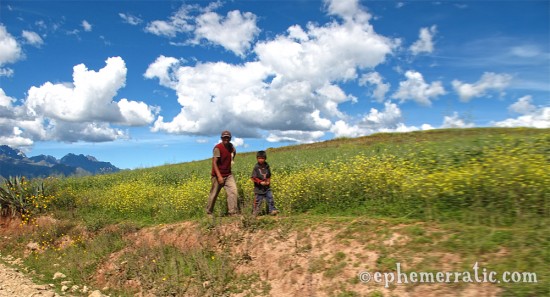
Walking a road through the Sacred Valley
We still get off cheaper than if we’d made arrangements back in civilization, such as it was, in Urubamba. The taxi touts at the town bus station must have thought Todd and I as green as the rain-plumped grass that’s been our Sacred Valley backdrop.
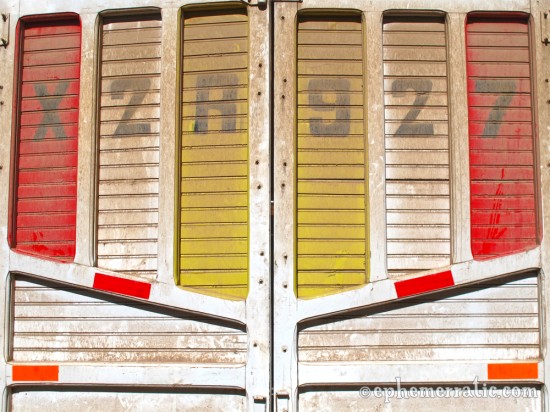
Colorful truck doors
The taxi touts had gathered close around us, trying to wear down our will with incessant English and Spanish sales pitches disguised as creepy attempts at friendly charm. They’d quoted us absurd prices for a taxi tour of Maras, Moray, and Salineras. When we declined, they’d pointed out the local bus that would drop us off at the turnoff to Maras. They’d told us it didn’t leave for an hour. We waved them away like the farts their stories resembled.
“Liars! Hah!” I shouted triumphantly as we boarded the correct bus just fifteen minutes later. Turning to Todd I said, “There was no way I’d leave our backpacks in the trunk of a car with any of those guys. Such liars!”
As the bus pulled out of the station, I resisted sticking out my tongue and giving the taxi touts the finger, unsure of the meaning of either gesture in Peruvian or Quechua cultures.
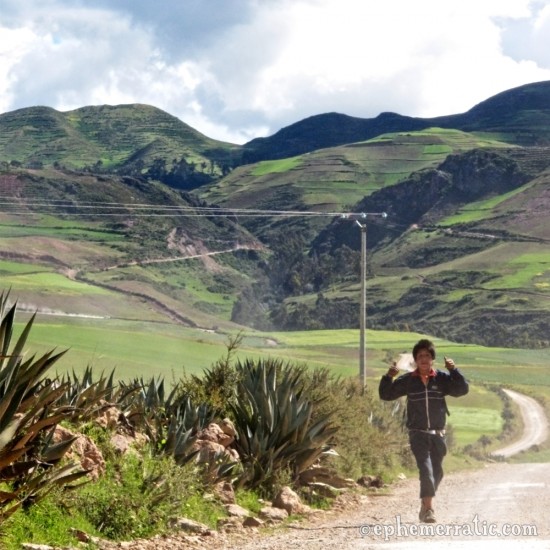
Thumbs up though does work
Later, while David taxis us through the gravel-rough roads from Maras to Moray to Salineras and back, Todd tries out his newly learned, rarely practiced conversational Spanish.

Scenic back road
As he pulls over to let us gawp at a local breed of condor, David tells us about his family, loves, and future plans, all intertwined. He’s a modern Peruvian stuck in the small village of Maras, home of low cost living and high taxi need, but too far from “big” city of Cusco, where his girlfriend and family live. He admits he speaks very little Quechua, the vanishing indigenous language spoken by his grandparents.

Condor of the Sacred Valley
Feeling a bit left out of their Spanish conversation, I toss out, “Cabrito! Mmmmm!” as we pass a herd of goats. This was not the thing to say if I was hoping to bond. David’s a pescatarian, a surprising find in the Peruvian countryside. He concedes that festivals are the toughest, being all about meat. But, since goat, beef, and alpaca all make him physically ill, not just psychologically adverse, he fills up on potatoes when he has to.
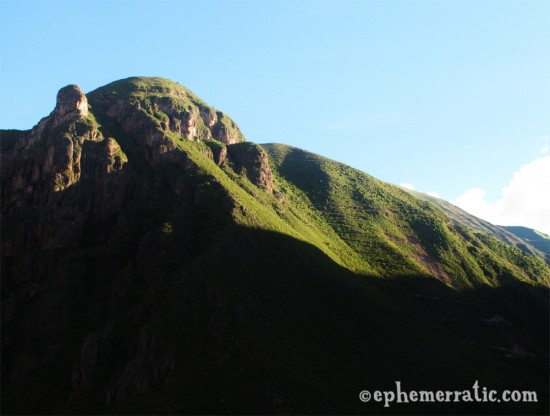
Mountainous landscape in Peru's Sacred Valley
Not one to be daunted by a conversational faux pas, I ask Todd to ask David about the land, about how showy bright the grass and flowers are, and about the rain that always threatens, but rarely appears.
As we drive by a mountain with a pass on fire, David says the rain has been good this year, unlike last. “Sólo una hora llovió,” he explains.
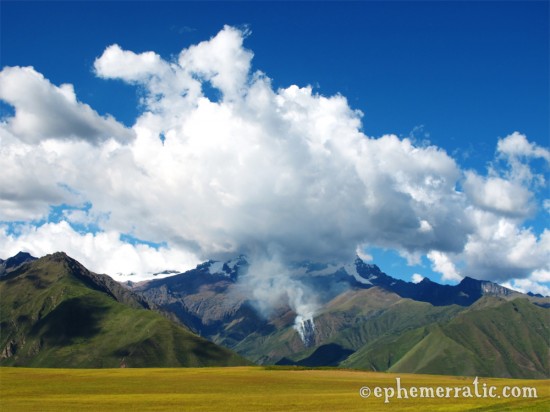
Mountain on fire in Peru's Sacred Valley
Though it’s hard to believe that it could only have rained for one hour in the whole of 2011, when we double check our Spanish deciphering, David assures us that in Maras, that’s how it went. That the clouds would gather and gray, but never come down into the valley from the surrounding mountains.
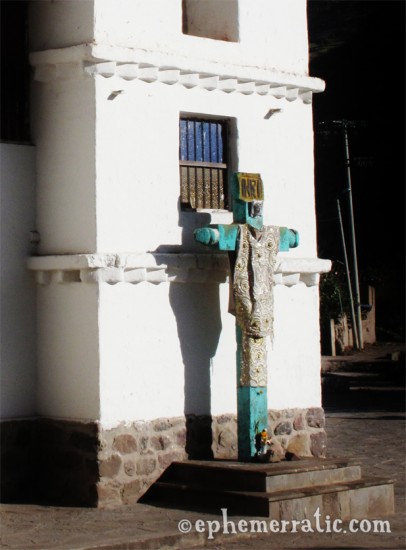
Teal cross in the country
Our slow ride finished, we shake David’s hand in farewell, and he leaves us where the turnoff to Maras meets the main road. Hefting our backpacks, we join a couple of locals in the shade, patiently hunkered for a bus, a combi, a colectivo—anything that will take us thataway.
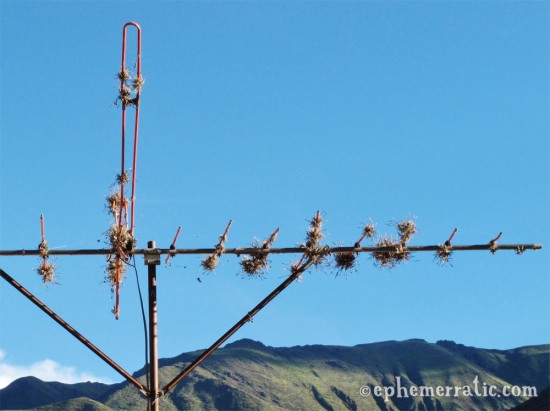
Air plants cling to an antenna
As we wait, music caught in a Doppler effect precedes the unseen thing that carries it up the hill. A moto soon appears; the Peruvian rickshaw hacked up and tricked out with speakers, flags, and instruments like a three-wheeled one man band-mobile. Before I can grab my camera, the music’s pitch lowers as the extra downhill momentum speeds the implausible DJ away.
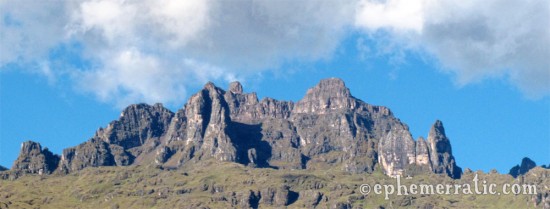
Mountains in the far distance
A barrel-chested Peruvian woman leaves our side and the shade, crossing to the opposite roadside where the approaching bus will board. Dust-caked knitted legwarmers slouching unevenly, long black braids riding the breeze, she sticks a finger deep in a nostril to get in one last pick. I’m too stunned by the contrast that her carefree snot spelunking makes with the unspoiled blue-sky scenery to think to take her picture.
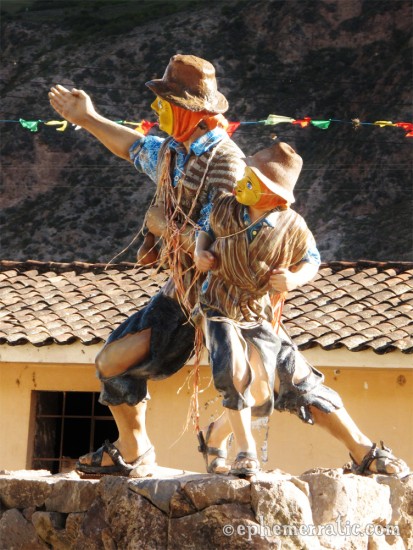
Yellow-masked statue of boy and man
More uncapturable scenes go by as we full throttle past small towns and villages, roadside stands, and ever more bus stops, constant like the EKG of the highway. Past allegoric mountain outcrops traced with alarming switchback trails. All the while, colorful statues of corn-wielding giants guard our way.
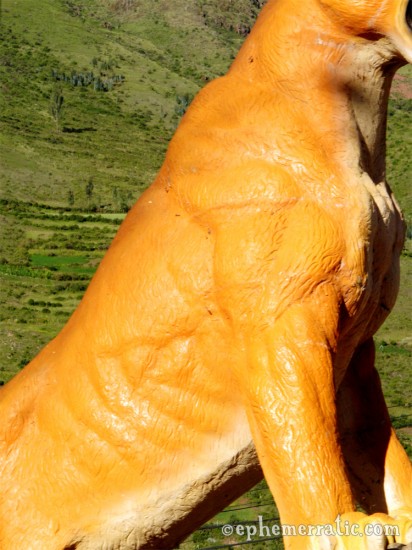
Sometimes you get the shot, sometimes...
____
Every photo in this post was taken from a moving vehicle. What’s your favorite photo taken while in motion?

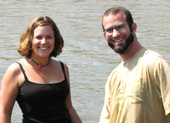
What a wonderful site you have here. I could spend the entire day daydreaming of all the places I’d like to see.
Thank you Letty, I’m so glad you like it!